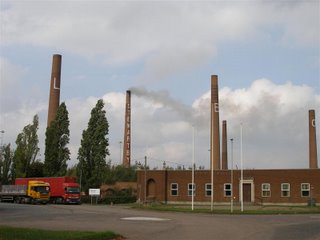The Bedford to Bletchley line is all that remains of a once important 77-mile cross-country route between the university cities of Oxford and Cambridge. Services east of Bedford and west of Bletchley were axed at the end of 1967. A remarkably short-sighted view as the closure came at the same time as this area of North Buckinghamshire was designated for the new city of Milton Keynes. The closure was even more surprising as the line had survived the merciless axe of Dr Beeching, so notorious for cutting up Britian's rail network in the mid-60's. The remaining section therefore between Bedford and Bletchley runs for about 16 miles serving some isolated communities en route, one reason for this section of line's continued survival. It has been threatened with closure many times although its future currently looks much more promising with recent heavy investment in the infrastructure.
Bletchley station is a miserable place. Its former glories as an important junction and locomotive depot have long since gone. The current station was the result of a 1960s rebuild when the line was electrified. It has spartan facilities and a squat and unattractive entrance building. The Bedford services generally depart from Platform 6, which is a long way, especially when you're in a hurry as I was yesterday! The impressive looking Bletchley power box, which also came with electrification in the 1960s, will soon become obsolete as signalling is moved to a new control centre at Rugby, as will Bletchley Motive Power Depot (MPD), when all train maintenance moves to Northampton Kings Heath. By the start of next year there really will be very little left of railway interest in Bletchley.
Still striking is the 1960s built concrete flyover which bisects the West Coast Main Line to the south of the station. This used to carry the Bedford-Bletchley trains onto Oxford. The track bed is still in place from the Oxford end as far as Calvert and is regularly used by household waste trains to the landfill site at the latter. Currently the flyover is back in use after many years of dereliction although this is only for the purposes of reversing freight trains and locomotives. There is still hope that the line can be restored throughout to Oxford and the government has given its backing, although no money, to the proposal.
Moving on from Bletchley, the train passes the Bletchley MPD and through the back of the industrial and commercial estates of Bletchley before its first stop in Fenny Stratford. You'll be pleased to note that I am now going to talk about something other than railways!
 A short walk from the station is this fabulous canal-side location. Unfortunately the weather wasn't too good when I took this picture although I think these cottages look particularly pretty. Its hard to believe that just beyond these cottages is an industrial estate! And not more than 15 minutes walk, the busy centre of Bletchley. The canal here is the Grand Union, which runs between London and Birmingham and is, I believe, navigable throughout. There used to be a port here, which attributed to the success and growth of Fenny Stratford before it was overtaken by its neighbour Bletchley with the arrival of the railway.
A short walk from the station is this fabulous canal-side location. Unfortunately the weather wasn't too good when I took this picture although I think these cottages look particularly pretty. Its hard to believe that just beyond these cottages is an industrial estate! And not more than 15 minutes walk, the busy centre of Bletchley. The canal here is the Grand Union, which runs between London and Birmingham and is, I believe, navigable throughout. There used to be a port here, which attributed to the success and growth of Fenny Stratford before it was overtaken by its neighbour Bletchley with the arrival of the railway. My first stop on my trip to the Marston Vale was Millbrook. Forgive me, I am going to talk about railways again! I did wonder whether anyone, on 'phoning National Rail Enquiries and speaking to their Indian call centre asking about train times, had been inadvertently diverted to the Millbrook near Southampton or vice versa. It would certainly be a long diversion from their intended destination! Millbrook station serves the village about a mile away although originally it was called Ampthill. The station buildings, which are now in private ownership, are typical of this end of the line. I believe the design has something to do with the Duke of Bedford, whose land the railway crossed. The building looks magnificent - why don't they build stations like this anymore?
My first stop on my trip to the Marston Vale was Millbrook. Forgive me, I am going to talk about railways again! I did wonder whether anyone, on 'phoning National Rail Enquiries and speaking to their Indian call centre asking about train times, had been inadvertently diverted to the Millbrook near Southampton or vice versa. It would certainly be a long diversion from their intended destination! Millbrook station serves the village about a mile away although originally it was called Ampthill. The station buildings, which are now in private ownership, are typical of this end of the line. I believe the design has something to do with the Duke of Bedford, whose land the railway crossed. The building looks magnificent - why don't they build stations like this anymore? The path to the Marston Vale is just behind me from where I took this photo. The walk starts by hugging close to the railway line and it is possible to follow the route to Stewartby, which I'll come to later.
The Marston Vale is a new community forest and from what I know, one of the Millennium Commission projects. Naturally it will take many years for the forest to mature and become, well, forest-like. However, it did offer a pleasent walk and there are many inviting paths leading off into various diversions.
 This next view was taken from one of the viewing points across Stewartby Lake. I am not entirely certain of this but I believe this was part of the brick works, which were later flooded. Brick making was a major employer and important industry in this part of Bedfordshire. It also provided important freight traffic to the railway, which finally ceased in the 1980s.
This next view was taken from one of the viewing points across Stewartby Lake. I am not entirely certain of this but I believe this was part of the brick works, which were later flooded. Brick making was a major employer and important industry in this part of Bedfordshire. It also provided important freight traffic to the railway, which finally ceased in the 1980s.
The walk around the lake is very enjoyable. It is mostly flat with well laid out paths, although some of the direction markers are a little ambiguous to say the least. It would be difficult to get lost as dominating the scene are the imposing chimneys of Stewartby brick works, which I'll come to shortly.
The Forest Centre is ideally located and formed a natural break in my walk. There are all the facilities needed - gift shop, restaurant, exhibitions, toilets and a place to hire bikes for those who want to take the cycle track.
 On the walk there are many of these attractively carved and decorated benches, which make a welcome respite for weary walkers like me! In all the complete trek around the whole Country Park and Forest is about 5 miles, I think I did about half that making my way from Millbrook to the Forest Centre then down round Stewartby Lake into Stewartby itself.
On the walk there are many of these attractively carved and decorated benches, which make a welcome respite for weary walkers like me! In all the complete trek around the whole Country Park and Forest is about 5 miles, I think I did about half that making my way from Millbrook to the Forest Centre then down round Stewartby Lake into Stewartby itself.
The village of Stewartby owes its existence to the brick making industry. Indeed the village was named after Malcolm Stewart, the chairman of the London Brick Company. The brick works still dominate the village and the picture below shows the fine chimneys, with their ' L', 'B' and 'C' lettering.
L', 'B' and 'C' lettering.
Stewartby station is like many of the stations on this line rather unusual in that it has staggered platforms either side of a level crossing. A busy road has to be crossed to get between the 'up' and 'down' platforms. Over the 'up' platform a conveyer servicing the brick works chugs away noisily. The sound of industry is heavy in the air around Stewartby.
However even a short walk away you come into the centre of a quintessentially English village. The centre is attractively laid out, with wide roads and pavements and a good spread of trees and grassed areas. It all looks rather nice and gentle. I doubt that many of the village's inhabitants work in the London Brick Company site. I get the impression that Stewartby today, like to many other villages, is the preserve of businessmen in their smart suits commuting to jobs in London. Opposite is a picture of the hall that stands in the centre of Stewartby, a rather fine and attractive building I think, which captures the essence of the village rather well.
in the London Brick Company site. I get the impression that Stewartby today, like to many other villages, is the preserve of businessmen in their smart suits commuting to jobs in London. Opposite is a picture of the hall that stands in the centre of Stewartby, a rather fine and attractive building I think, which captures the essence of the village rather well.
After a walk around Stewartby, I rejoined the train for the remainder of the short journey to Bedford (Midland) and a couple of hours break there. Bedford is not a place that I would be likely to go to again. It seemed to me a very intimidating town; a tired and wearisome centre, a pit of a bus station and drunks and tramps shuffling along the pavements. Not to mention the large groups of youths that just seemed to be waiting to cause mischief. The place frankly had an air of decay and neglet, a pregnant promise of something ugly.
Back on the train at Bedford (Midland) for the full run back to Bletchley. The journey takes about 40 minutes, which is not quick by any means but it provides a vital community service linking many rural and isolated communities and taking their inhabitants to work, shopping and just out for the day. The future is bright for the line if the proposed extension to Oxford goes ahead although there is much more that could be done in the meantime to encourage its use for leisure opportunities. The Marston Vale is certainly well worth a visit and hopefully it won't be long before I make another visit.

2 comments:
lovely.
at some point of convenience in the near fututre,we should arrange a canal boat holiday...
i think it would be nice.
Sounds like a good tour. Your description of Bedford sounded vaguely familiar. Sure you weren't in Nuneaton? ;)
Post a Comment